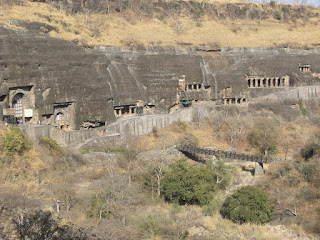The complex consists of 29 caves dug into the rock wall of a horse shoe shaped river bank. The caves are believed to have been created in two phases. Only five caves were excavated in the first phase which took place in the second century AD. The second, and much larger, phase began in the 400s AD when the remaining 24 caves were excavated.
The later caves feature grand carvings of Buddha and in many the original paint is still visible.
Some of the caves are tall and narrow, like the one shown below, but most of the caves are short and very wide with column as supports, like the second picture.
The main Buddha carvings are the centerpiece of most caves but my favorites were often simple decorations leading in to the caves (above) or on support columns (below).
As we were leaving, a group of school children swarmed Ellie and I asking if they could take pictures with us. We were all too happy to oblige, but only on the condition that we could take a picture with them.
After a few hours in the caves, the sun was beginning to set and we needed to get back to Aurangabad to catch the train. After a few minutes waiting by the road, we waved down a creaky old bus and hopped on. There were three passengers on bench seat and a few standing in the aisle but all were surprisingly helpful as we struggled to find a place for our over sized baggage.
We got back to Aurangabad in time for a big dinner and a brief stop at an internet cafe before boarding the train back to Bombay.








No comments:
Post a Comment